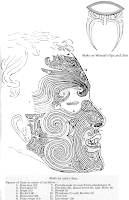 The Maori people are the native indigenous people of New Zealand. They are believed to have lived their since 800 to about 1300AD. They are believed to have come in migration waves from Polynesia, in large ocean going canoes. One of their most idealistic and most recognisable attributes to their history is their traditional tattoo’s.
The Maori people are the native indigenous people of New Zealand. They are believed to have lived their since 800 to about 1300AD. They are believed to have come in migration waves from Polynesia, in large ocean going canoes. One of their most idealistic and most recognisable attributes to their history is their traditional tattoo’s. According to Maori mythology the idea of tattooing derives from an ancient story of love. The young man fights with the princess and she goes to her fathers heavens. The man, filled with guilt goes after the princess. After many trials and obstacles he reaches the fathers realm. His face paint being messed th
According to Maori mythology the idea of tattooing derives from an ancient story of love. The young man fights with the princess and she goes to her fathers heavens. The man, filled with guilt goes after the princess. After many trials and obstacles he reaches the fathers realm. His face paint being messed the family laugh at him. Then in his state he asks for forgiveness, she accepts and her father then offers to teach the man tattooing. Then after learning the art, he and his princess return as human, with his newly found tattooing skills.

Early Polynesia tattooing was done with bone, or ivory, tools and applied in a chiselling manner. The tattoo’s represented status and those without were considered to have no social class. The head was considered to be the most sacred part of the body and most respectful place to apply the fine art.
The process would begin with the firstly carving deep cuts into the face
and then applying a deep pigmented soot, or burnt gum, into the face through tapping it into the skin. This process would be very time consuming.
 The patterns each have their own meaning and styles. The face was usually divided into eight different sections, each having their own meaning. For men it could act like a passport almost
The patterns each have their own meaning and styles. The face was usually divided into eight different sections, each having their own meaning. For men it could act like a passport almost, showing their rank, lifestyle, marriage and birth status, as well as work.
The male facial tattoo also known as the ‘Moko’, the eight sections are:Ngakaipikirau (rank), The center forehead area
Ngunga (position), Around the brows
Uirere (Hapu rank), The eyes and nose area
Uma (first or second marriage), The temples
Raurau (signature), The area under the nose
Taiohou (work), The cheek area
Wairua (Mana), The chin
Uirere (Hapu rank), The eyes and nose area
Uma (first or second marriage), The temples
Raurau (signature), The area under the nose
Taiohou (work), The cheek area
Wairua (Mana), The chin
Taitoto (birth status), The jaw

The women weren’t as extensively tattooed as the men. Usually they would just get it applied
to the upper and bottom lip. This ancient tradition has kept on even today in some New Zealanders, though the technique is obviously a lot different.
Bibliography:
http://history-nz.org/maori3.html
http://en.wikipedia.org/wiki/Māori
http://homepages.ihug.co.nz/~tonyf/explore/explore.html
http://www.maori.geek.nz/blog/?cat=10
http://www.pbs.org/skinstories/artists/newzealand.html
No comments:
Post a Comment